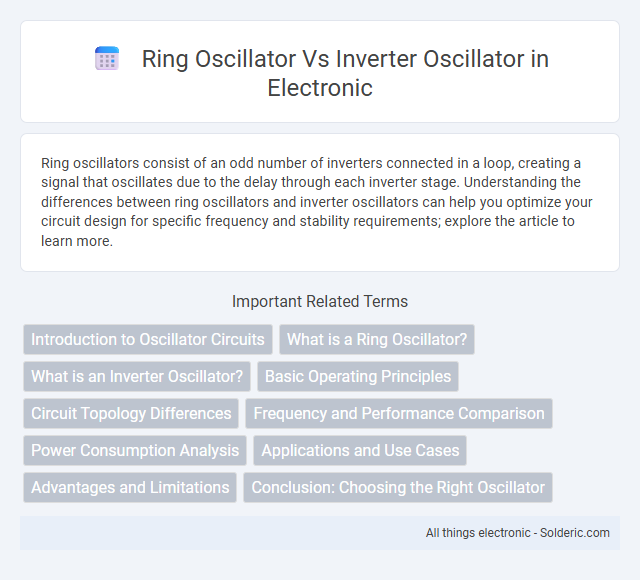Ring oscillators consist of an odd number of inverters connected in a loop, creating a signal that oscillates due to the delay through each inverter stage. Understanding the differences between ring oscillators and inverter oscillators can help you optimize your circuit design for specific frequency and stability requirements; explore the article to learn more.
Comparison Table
| Feature | Ring Oscillator | Inverter Oscillator |
|---|---|---|
| Basic Structure | Odd number of inverters connected in a ring | Single inverter with feedback components (resistor, capacitor) |
| Oscillation Principle | Delay through multiple inverters creates oscillation | RC feedback network produces the oscillation |
| Frequency Range | High-frequency operation (MHz to GHz) | Low to medium frequency (kHz to MHz) |
| Tuning Capability | Frequency adjusted by number of stages or supply voltage | Frequency adjusted by resistor or capacitor values |
| Output Waveform | Digital-type square wave | Approximate sine wave or distorted waveform |
| Power Consumption | Higher power due to rapid switching of multiple inverters | Lower power consumption, simpler design |
| Applications | Delay measurement, clock generation in ICs | Signal generation in analog circuits, clock circuits |
Introduction to Oscillator Circuits
Oscillator circuits generate periodic signals essential for clock generation and timing applications, with ring oscillators and inverter oscillators being common types. A ring oscillator consists of an odd number of inverters connected in a loop, producing oscillations by the propagation delay through each inverter stage. Your choice between these oscillators depends on required frequency accuracy, phase noise, and integration complexity in your circuit design.
What is a Ring Oscillator?
A ring oscillator is a digital oscillator consisting of an odd number of inverter stages connected in a loop, where the output oscillates due to the propagation delay through each inverter. It is widely used for measuring process variations, device speed, and temperature sensing in integrated circuits. The frequency of a ring oscillator is determined by the number of stages and the delay per stage, offering a simple and compact timing reference compared to inverter oscillators with additional feedback components.
What is an Inverter Oscillator?
An inverter oscillator is a type of electronic oscillator that uses a single inverter gate to generate a periodic oscillating signal. It operates by leveraging the inverter's inherent delay and feedback loop to produce a continuous square wave output. Unlike ring oscillators, which consist of multiple inverters connected in a loop, inverter oscillators typically rely on a single inverter combined with external components such as resistors and capacitors to control oscillation frequency.
Basic Operating Principles
A ring oscillator consists of an odd number of inverters connected in a series loop, where the output of the last inverter feeds back to the input of the first, producing oscillations due to the cumulative propagation delay. An inverter oscillator typically employs a single inverter with a feedback network, such as a resistor-capacitor (RC) circuit, to create a phase shift that sustains oscillation. The fundamental difference lies in the source of phase shift: ring oscillators rely on inverter delays around the loop, while inverter oscillators use external reactive components to generate the necessary phase shift.
Circuit Topology Differences
Ring oscillators consist of an odd number of inverters connected sequentially in a loop, creating a feedback path that produces oscillations, whereas inverter oscillators typically use a single inverter with additional feedback components such as resistors or capacitors to sustain oscillation. The ring oscillator's delay and frequency are determined by the number of stages and propagation delay of each inverter, while inverter oscillators rely on the RC time constant for frequency control. This fundamental topology difference impacts the complexity, frequency range, and stability characteristics of the oscillators.
Frequency and Performance Comparison
Ring oscillators typically generate higher frequencies due to multiple inverter stages creating a cumulative delay, while inverter oscillators often operate at lower frequencies with more predictable performance. The frequency of a ring oscillator depends on the number of inverters and their individual delays, providing flexibility but potentially higher phase noise. Your choice between the two impacts performance metrics such as frequency stability and power consumption, with ring oscillators offering faster oscillation at the cost of increased jitter compared to simpler inverter oscillators.
Power Consumption Analysis
Ring oscillators typically exhibit higher power consumption due to multiple inverters arranged in a loop, causing continuous switching activity and dynamic power dissipation. Inverter oscillators, consisting of a single inverter with feedback, generally consume less power as they involve simpler circuit topology and reduced transition events. Analyzing power consumption requires considering parameters such as supply voltage, switching frequency, and load capacitance, which impact dynamic and static power in both oscillator types.
Applications and Use Cases
Ring oscillators excel in integrated circuit testing and variability analysis due to their simple structure and sensitivity to process, voltage, and temperature changes. Inverter oscillators are widely used in clock generation and timing circuits where stable frequency generation is essential, leveraging their ease of integration in digital systems. Your choice depends on whether you need precise frequency control for system clocks or a tool for monitoring semiconductor manufacturing performance.
Advantages and Limitations
Ring oscillators offer simple design and compact size, making them ideal for high-frequency applications and process variation testing. However, they suffer from less frequency stability and higher phase noise compared to inverter oscillators. Your choice depends on whether you prioritize ease of integration and speed or require better frequency accuracy and lower jitter performance.
Conclusion: Choosing the Right Oscillator
Ring oscillators offer simplicity and ease of integration for frequency generation in digital circuits, making them ideal for testing and calibration purposes. Inverter oscillators provide more stable frequency outputs suitable for precision timing applications, benefiting from controlled feedback and design customization. Selecting the right oscillator depends on balancing requirements for frequency stability, integration complexity, and application-specific performance criteria.
ring oscillator vs inverter oscillator Infographic

 solderic.com
solderic.com